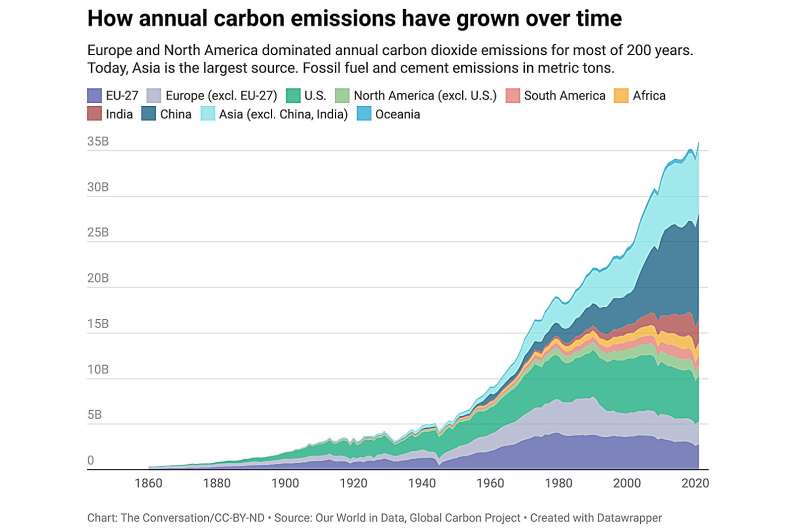Don't applaud the climate summit's loss and damage fund deal just yet

Shortly after the opening ceremony of the in Dubai, delegates of nations around the world rose in a standing ovation to celebrate a long-awaited agreement to launch a loss and damage fund to help vulnerable countries recover from climate-related disasters.
But the applause might not yet be warranted. The deal itself leaves much undecided and has been met with criticism by climate justice advocates and front-line communities.
I teach and have been attending and observing these negotiations for over a decade to follow the demands for just climate solutions, including loss and damage compensation for countries that have done the least to cause climate change.
A brief history of loss and damage
"" was the term often used to describe the decision at 2022's COP27 climate conference to finally construct a loss and damage fund. Many countries rejoiced at this "" agreement—it came 31 years after Vanuatu, a small archipelago in the Pacific, for loss and damage for climate-caused sea level rise in earlier negotiations.
The agreement was only a framework, however. Most of the details were left to a transitional committee that met throughout 2023 to forward recommendations on this new fund to COP28. A found that funding from wealthy nations to help poorer countries adapt to the ravages of climate change grew by 65% from 2019 to 2020, to $US49 billion. That's still far below the the U.N. estimates will be needed annually by 2030.
As the , developing nations, long wary of traditional financial institutions' , which have left many low-income countries mired in debt, proposed that the fund be independent. Developed nations, however, insisted the fund be hosted under the World Bank and until .
Devil is in the details
While any deal on funding for climate disaster damages was sure to be portrayed as a historic win, further investigation suggests that it should be welcomed with hesitation and scrutiny.
First, the fund contains no specifics on scale, financial targets or how it will be funded. Instead, the decision merely "invites" developed nations to "take the lead" in providing finance and support and encourages commitments from other parties. It also fails to detail which countries will be eligible to receive funding and vaguely states it would be for "economic and non-economic loss and damage associated with the adverse effects of climate change, including extreme weather events and slow onset events."
So far, pledges have been underwhelming.
Calculations of , with Germany and the United Arab Emirates pledging $100 million and the U.K. committing $75 million. The United States, one of the largest climate change contributors, pledged only $17.5 million in comparison. It's a .
Also, any notion that this fund represents liability or compensation by developed countries—a major concern for countries with long histories of carbon pollution—was removed entirely. It in fact notes that loss and damage response is based on cooperation instead.
In a rare win for the developing world, funds were made available—even at subnational and community levels—to all nations, though with yet-undetermined performance indicators.
Additional concern has been raised about the fund's interim host—the World Bank. In fact, deciding on a host institution was one of the sticking points that nearly derailed earlier talks.
On one side, the United States and other the fund be hosted by the World Bank, which has and has . Developing countries, however, resisted the World Bank's involvement based on their with its lending and structural adjustment programs and noting the bank's role for years in financing oil and gas exploration as cornerstones of development efforts.
Following a stalemate and , a compromise was reached to host the fund under the World Bank for four years, with guardrails to ensure its independence and impact. After this window, the host structure will be reviewed, leading to either a fully independent fund or continuation under the World Bank.
The concern for critics with this route is that the compromise .
And there are more issues, such as the fund board's composition, which only allows for national representatives, not civil society representatives such as from Indigenous groups, as developing countries requested. The scope of funding that will be allowed is also still up in the air. In the fund's vague state, it opens the door for countries, as part of their loss and damage funding commitments, to count private loans, conditional import credits and even funding from the fossil fuel industry at the .
What happens next, starting in 2024
To date, the international climate community does not have a solid track record when it comes to climate finance promises. Each successive fund—from the that supports green projects in the developing world to the that builds climate resilience for the most vulnerable nations—has been woefully undersourced from inception.
In 2021, the entire climate finance ecosystem, from national commitments to private investment, totaled . Experts indicate that .
That target represents 20% year-over-year growth until the end of this decade—a significant ramp up from recent years.
From 2011 to 2020, total climate finance . If this trend continues, not only will developing and most vulnerable countries lose faith in this process, but the very need for loss and damage funding will only grow.
The new fund board is mandated to hold its first meeting by Jan. 31, 2024. While this early start time is laudable, droughts will continue killing crops, and storms will continue flooding homes while the new fund engages in another series of meetings to determine who will qualify, how they can apply and how and when funds will actually be dispersed.
Provided by The Conversation
This article is republished from under a Creative Commons license. Read the .![]()





















